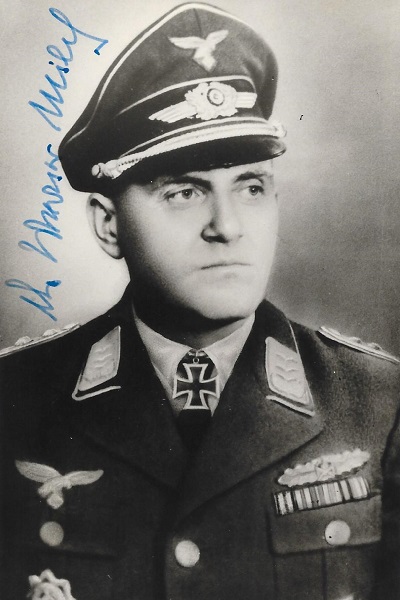Milch, Werner Wolfgang Eberhard (Fallschirmjäger)
- Date of birth:
- November 15th, 1903 (Wilhelmshaven/Hannover, Germany)
- Date of death:
- November 17th, 1984 (Hemer/Northrhine-Westphalia, Germany)
- Nationality:
- German
Biography
Brother of Erhard Milch (1892-1972)
Promotions:
March 1st, 1937: Gefreiter d.R.;
August 20th, 1937: Unteroffizier d.R.;
September 16th, 1937: Wachtmeister d.R.;
March 1st, 1939: Leutnant d.R. (591);
October 31st, 1941: Oberleutnant d.R. mit RDA vom 1-10-1941 (372);
January 23rd, 1943: Hauptmann d.R. mit RDA vom 1-1-1943;
January 1st, 1945: Major d.R.
Career:
00.04.1924: entered the Reichsheer, in the army for only a few weeks, trained with Art.-Rgt. 2
00.00.1926: assigned to the 6. Preuss.Art.Rgt.
00.00.1937: returned to the army as a reservist, assigned to Art.Rgt. 3
01.03.1939: promoted to Leutnant d.R.
00.09.1939-00.05.1940: with Art.Rgt. 603
00.07.1941: WIA in north sector of Russia
31.10.1941: promoted to Oberleutnant d.R.
17.12.1941: transferred to the Luftwaffe, assigned to 5. Batterie, Fsch.Jg. Rgt. 1
00.08.1942: Chef of a Kp. in Fsch.Jg.Art. Rgt. 2
23.01.1943: promoted to Hauptmann d.R., Führer 4. Batterie, Fsch.Art. Rgt. 2
00.06.1943: transferred to 2. Fsch.Jg.-Div.
22.12.1943: Hptm., Kdr. II./ Fallschirm-Art.Rgt.2
00.12.1943-00.01.1944: Kdr. II./ Fsch.Jg.Rgt. 2
21.03.1944: Hptm., Kdr. Fallschirm-Granatwerfer-Btl. 2
15.04.1944: Hptm., awarded DKiG, Stab, II./ Fsch.-Art.Rgt. 2
00.08.1944: Kdr. of Fsch.Granatwerfer Lehr u. Vers.Btl.
01.01.1945: promoted to Major d.R. transferred to Fsch.Jg.Div. 7.
09.01.1945: Hptm.d.R. and Kdr. Fsch.Granatwerfer Lehr u. Vers.Btl., awarded the Ritterkreuz
08.05.1945: Major d.R captured by the Allies
Do you have more information about this person? Inform us!
- Period:
- Second World War (1939-1945)
- Awarded on:
- May 16th, 1940
- Period:
- Second World War (1939-1945)
- Awarded on:
- July 19th, 1941
- Period:
- Second World War (1939-1945)
- Awarded on:
- February 18th, 1942
- Period:
- Second World War (1939-1945)
- Awarded on:
- July 1st, 1942
- Period:
- Second World War (1939-1945)
- Awarded on:
- October 19th, 1942
- Period:
- Second World War (1939-1945)
- Awarded on:
- December 15th, 1942
- Period:
- Second World War (1939-1945)
- Awarded on:
- 1943
- Period:
- Second World War (1939-1945)
- Awarded on:
- March 5th, 1943
- Period:
- Second World War (1939-1945)
- Awarded on:
- May 1st, 1943
- Period:
- Second World War (1939-1945)
- Period:
- Second World War (1939-1945)
- Awarded on:
- November 1943
- Period:
- Second World War (1939-1945)
- Rank:
- Hauptmann (Captain)
- Unit:
- Stab, II. Abteilung, Fallschirm-Artillerie-Regiment 2, 2. Fallschirmjäger-Division, Luftwaffe
- Awarded on:
- April 15th, 1944
He is written in Patzwall / Scherzer as Milch, Dr., Werner
- Period:
- Second World War (1939-1945)
- Rank:
- Hauptmann der Reserve (Captain of Reserves)
- Unit:
- Kommandeur, Fallschirm-Granatwerfer-Lehr und Versuchs-Bataillon, 1. Fallschirm-Armee, Luftwaffe
- Awarded on:
- January 9th, 1945
“Hauptmann Milch has repeatedly distinguished himself throughout his period of attachment to Kampfgruppe Oberst Eggers via a combination of personal bravery, appropriate appraisal of tactical situations and exemplary troop leadership. He and his assault troop were decisively involved in the military success of Kampfgruppe Oberst Eggers at Flavigny.
On the evening of the 10.09.1944 the Americans launched a surprise thrust near Flavigny with their II. Battalion / 134th Infantry Regiment, and they managed to establish a bridgehead after capturing bridges across the Mosel and Ostkanal. Realizing the major threat that now presented itself for the entire Mosel front, Hauptmann Milch decided to thrust forward on his own initiative with an assault troop. Utilizing the results of reconnaissance that had been obtained in advance, he managed to get through to the bridges themselves by skillfully exploiting weak points in the American lines. By doing this he split the American forces and prevented the enemy from sending reinforcements across the bridges. Hauptmann Milch then held the position that had been reached amidst heavy infantry fire and close combat.
By doing this he paved the way for the rest of the Kampfgruppe to conduct the necessary measures for the elimination of the bridgehead. Weak forces (assembled from the Kampfgruppe staff and the staff of the Artillerie-Abteilung from Art.Rgt. 1553) launched a pincer-like counterthrust against the bridgehead, and they managed to restore contact with Hauptmann Milch and his assault troop. The bridges were destroyed, the entire enemy battalion was wiped out. Of the enemy battalion, 257 prisoners were captured and about 70-80 dead were counted east of the Mosel. The combat situation, combined with prisoner statements, suggest that the enemy also sustained high numbers of dead and wounded on the west bank.”
Sources
- Photo 1: Known to STIWOT
- - FELLGIEBEL, W.P., Elite of theThird Reich, Helion & Company Limited, Solihull, 2003.
- PATZWALL, K. & SCHERZER, V., Das Deutsche Kreuz 1941-1945, Band II, Verlag Klaus D. Patzwall, Norderstedt, 2001.
- THOMAS, FRANZ & WEGMANN, GüNTER, Die Ritterkreuzträger der Deutschen Wehrmacht 1939-1945, Biblio-Verlag, 1986.
- Vorschlag für die Verleihung des Ritterkreuzes des Eisernen Kreuzes
- BArch RL 1/97














